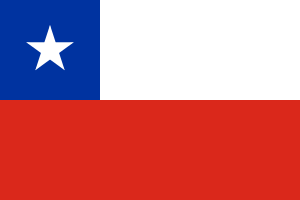Chileans

|
|
| Total population | |
|---|---|
| c. 18.5–19 million | |
| Regions with significant populations | |
|
|
|
|
|
429,708 |
|
|
113,934 |
|
|
42,396 |
|
|
37,577 |
|
|
33,626 |
|
|
28,371 |
|
|
27,106 |
|
|
23,911 |
|
|
15,782 |
|
|
10,280 |
| Other countries | 95,090 |
| Languages | |
| Chilean Dialect (Spanish) | |
| Religion | |
| Roman Catholicism (69,95%), Evangeliscalism (9%), European Protestantism (6,14%), Non religion (8,30%), Judaism (0,13%) | |
| Related ethnic groups | |
| Mapuches, Castizos, Andalusians (Spaniards), Extremenians (Spaniards), Basques (Spaniards), Castilian (Spaniards), Other Europeans, Indigenous People | |
|
a. ^ The "total population estimation is merely a sum of all the referenced figures in the table and as such might be understated or exaggerated. |
|
Chileans (Spanish: Chilenos) are natives of and long-term immigrants to Chile. Chileans are mainly the admixture of Spanish descent with indigenous peoples, with small, albeit important, degrees of 19th- and 20th-century European immigrant ancestry. There is a strong correlation between Chilean people's ancestry or ethnicity and socioeconomic situation: a marked continuum exist between the lower classes of high Amerindian ancestry and the upper classes of mainly European ancestry. Indigenous inheritance (cultural or genetic) is most visible in rural areas and in aspects of culture such as Chilean cuisine and Chilean Spanish. Although post-independence immigrants never made up more than 2% of the population, there are now hundreds of thousands of Chileans with German, British, French, Croatian, Italian or Palestinian ancestry.
Though the majority of Chileans reside in Chile, significant communities have been established in multiple countries, most noticeably Argentina and the United States. Other large Chilean communities are in Australia, Canada and Sweden. Although small in number, Chilean people also make up a substantial part of the permanent population of Antarctica and the Falkland Islands (see: Chileans in the Falkland Islands).
As in other Latin American countries, in Chile, from the onset of Spanish colonization and settlement, miscegenation or mestizaje was the norm rather than the exception. Today, ethnic and racial self-identities are highly fluid and can differ between persons of the same family, including siblings of the same parentage. It is dictated not only by strict physical appearance, nor more loosely by ancestry (actual or presumed), but by cultural patterns, social class, wealth and access, language, and prevailing biases of the era. These very factors, indeed, lend to the significantly varying ethnic structure figures from one source to the next. Additionally, those various figures refer to different, even if often overlapping, concepts: including racial vs ethnic categories, self-identity vs genetic findings, as well as culturally assigned categories. These concepts should not be confused, and the figures represented in one source might not be corresponding to figures of concepts from another source.
...
Wikipedia
